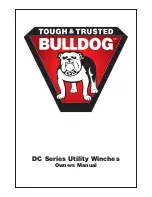
CEQUENT
™
PERFORMANCE PRODUCTS, INC.
3
Before First Operation
• Purchaser/owner must ensure that
product is installed according to
these instructions. Purchaser/owner
must not alter or modify product.
•
Understand your winch and its
instructions.
•
•
Never exceed maximum rated ca-
pacity. Refer to stamped markings or
decals on product to obtain rated ca-
pacity.
The winch is rated at the first layer of
wire/synthetic rope on the drum for
intermittent-periodic duty.
Are you ready to pull?
•
Your
winch can develop tremendous
pull forces and if used unsafely or
improperly could result in property
damage, serious injury or death.
Ultimately, safe operation of this
device rests with you, the operator.
• NEVER operate this winch when
under the influence of drugs, alcohol
or medication.
•
ALWAYS remove jewelry
and wear eye protection.
•
Use leather gloves or a hand
saver cable strap when handling the
wire rope.
• NEVER let winch rope slip through
your hands.
• Never touch a winch rope or hook
when someone else is at the
controls.
• NEVER touch winch rope or hook
while under tension or under load.
• ALWAYS stand clear of winch rope
and load and keep others away while
winching.
•
Do not use the winch
as a lifting device or a hoist for
vertical lift.
• Operator and bystanders should
never position any part of body under
any portion of this product or the
load being supported.
• Do not allow children to play on or
around this product or the load being
supported.
•
Keep
clear of winch, rope, hook, and
fairlead while operating.
•
The winch is not to be used
to lift, support or otherwise transport
personnel.
•
ALWAYS be aware of
possible hot surfaces at winch motor,
drum or rope during or after winch
use.
• ALWAYS ensure the operator and
bystanders are aware of the stability
of the vehicle and/or load.
Is your winch ready to pull?
• ALWAYS inspect winch rope, hook,
and slings before operating winch.
Frayed, kinked or damaged winch
rope must be replaced immediate-
ly. Damaged components must be
replaced before operation.
• Periodically check mounting hard-
ware for proper torque and tighten if
necessary.
• ALWAYS remove any element or
obstacle that may interfere with safe
operation of the winch.
• ALWAYS be certain the anchor you
select will withstand the load and the
strap or chain will not slip.
• Wire/synthetic rope can break
without warning. Always keep a safe
distance from the winch and rope
while under a load.
• ALWAYS keep wired pendant control
lead and power cord clear of the
drum, rope, and rigging. Inspect
for cracks, pinches, frayed wires
or loose connections. Damaged
components must be replaced before
operation.
•
NEVER wrap winch rope
back onto itself. Use a choker chain
or strap.
•
ALWAYS ensure hook latch
is closed and not supporting load.
•
NEVER apply load to hook tip
or latch. Apply load only to the center
of hook.
• NEVER use a hook whose throat
opening has increased, or whose tip
is bent or twisted.
• ALWAYS use a hook with a latch.
• Never use winch rope for towing.
• NEVER use excessive effort to free
spool winch rope.
• ALWAYS take time to use appropriate
rigging techniques for a winch pull.
During the pull
• NEVER exceed winch or winch rope
rated capacity. Double line using a
snatch block to reduce winch load.
• Do not shock load the winch.
• Never use a winch to secure a load.
• ALWAYS unspool as much winch
rope as possible when rigging. Dou-
ble line or pick distant anchor point.
• Never engage or disengage the
clutch when the winch is under load
or the drum is moving.
• Try to pull from an angle of less than
5 degrees laterally and 15 degrees
horizontally. Short pulls of up to 45
degrees laterally are acceptable;
however without maintaining the
proper fleet angle of +/- 5 degrees;
the rope will pile onto one side of the
rope drum and possibly do damage
to the rope or winch. Re-spool your
winch as required.
• When winching a heavy load, lay a
recovery damper or a heavy blanket
over the wire rope near the hook end.
• ALWAYS avoid side pulls which can
pile up winch rope at one end of the
drum. This can damage winch rope
or winch.
• ALWAYS ensure the clutch is fully
engaged or disengaged.
• NEVER submerge winch in water.
After Use
• Disconnect the hand held pendant
from the winch when not in use.
• ALWAYS store the pendant control in
a protected, clean, dry area.
Important Safety Messages

















